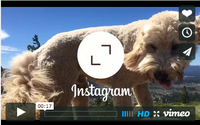 Giving users
and advertisers more creative license, Instagram is breaking its square-shaped confines. “In addition to square posts … you can now share photos and videos in both portrait and landscape
orientation,” the social network said in a blog post on Thursday.
Giving users
and advertisers more creative license, Instagram is breaking its square-shaped confines. “In addition to square posts … you can now share photos and videos in both portrait and landscape
orientation,” the social network said in a blog post on Thursday.
The change was inspired by the internal insight that nearly 20% of photos or videos posted to Instagram are not
originally in square format.
“We know that it hasn’t been easy to share this type of content on Instagram,” the network admitted on
Thursday. “Friends get cut out of group shots, the subject of your video feels cramped and you can’t capture the Golden Gate Bridge from end to end.
Now, instead of a square, users can tap the format icon to adjust the orientation of their content to portrait or landscape. Once they share a photo, a full-sized
version will appear to all of their followers in feed. To keep the flawless feel of users’ profile grid, posts will appear there as a center-cropped square.
advertisement
advertisement
Meanwhile, while Instagram has historically had separate filters for photos and videos, all filters now work on all types of content. Industry experts say the changes
have big implications for advertisers.
“The same 16:9 format that they use for TV ads should also work well in Instagram's landscape layout,” said Pixlee CEO Kyle Wong. "In
particular, “This landscape functionality could be very beneficial to the travel industry because you no longer need to crop out parts of your scenery,” Wong noted.
Wong added: “This could be useful to brands during the upcoming shopping season, allowing them to easily showcase head-to-toe style shots." While positioned as a
benefit for users, the changes were clearly made with advertisers in mind.
Ortega, Don Julio, Ruby Tuesday, and Mountain Dew are already testing the new posting
options. Said Jordan Greenberg, vice president of marketing at B&G Foods: “We were thrilled to see Instagram introduce new dimensions for images today.” “As a
brand, we're excited about finding new ways to activate consumers and today's Instagram update presented a perfect opportunity for this," Greenberg added.
Going forward, analysts are expecting big things from Instagram. eMarketer now expects the Facebook unit’s global mobile ad revenues to reach $2.81 billion -- or
about 10% of Facebook's global ad revenues -- by 2017.
If accurate, Instagram will then have higher net mobile display ad revenues than both Google and Twitter.
This year alone, Instagram will rack up $595 million in mobile ad revenue around the globe, eMarketer expects.
The research firm attributes the “rapid
growth” to high demand for Instagram’s new ad products, which -- coupled with better measurement and targeting features -- are expanding beyond branding to include direct response and the
ability to buy ads via API.
“Now that Instagram is opening up, there is a lot of pent-up demand,” Debra Aho Williamson, principal analyst at
eMarketer, recently explained. “The roll out of new features over the next several months means that by the end of 2015, Instagram will have a host of new ad products for advertisers large and
small.”
“In particular, Instagram advertisers will be able to use a full slate of Facebook targeting tools, including the popular Custom Audiences
feature,” she added. “That will be a key drawing card.”
Over the past 18 months, Instagram has slowly rolled out a number of ad units. It
recently introduced Carousel ads, which
encourage users to swipe left for additional images, and -- later in the “carousel” -- a link to a brand's mobile site.
So far, Instagram says its ad
units have performed well. Across more than 475 campaigns measured globally with Nielsen Brand Effect, ad recall from sponsored posts on Instagram was nearly 300% higher than Nielsen's norms for
online advertising.